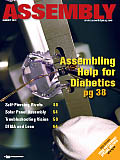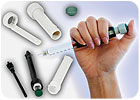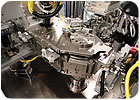
One out of every 10 American adults currently has diabetes. However, a recent government report warns that the disease may skyrocket over the next four decades, due to a number of factors. As a result, medical device engineers are scrambling to develop products that are less invasive, easier to use and cheaper to mass-produce.
Diabetes is the seventh leading cause of death in the United States. It’s the leading cause of kidney failure, nontraumatic leg and foot amputations among adults, and new cases of blindness among adults under age 75.
According to the International Diabetes Federation, more than 280 million people worldwide are currently living with the disease, but that number is expected to skyrocket to 438 million by 2030. If current trends, such as widespread obesity and lack of exercise, continue in the United States, the Center for Disease Control and Prevention predicts that one-third of adults could have diabetes by 2050.
Because of this alarming trend, there will be a massive increase in the number of devices manufactured to combat diabetes and treat patients. Manufacturers are ramping up production of lancets, syringes, insulin pumps, glucose monitoring systems and other devices used by diabetics.
Patrick Driscoll, president of MedMarket Diligence LLC, says that diabetes management products represent a $36 billion global market that’s on pace to cross $100 billion annually within a few years.
“The steady growth in diabetes worldwide, driven by increased prevalence of obesity, demographic trends and other forces . . . creates an enormous opportunity for new technology development by [medical device] manufacturers,” says Driscoll. “[They] have steadily developed new technologies that continue to improve the management of the disease by reducing the burden on patients, reducing the incidence of diabetes-related complications, and reducing the overall cost of the disease on healthcare systems.
“The trends and the challenges have been the same in diabetes for some time,” adds Driscoll. “So, there has been, at best, a slow and steady rate of innovation rather than any wholesale leaps or advances in products.”

Dynamic Market
Traditionally, diabetics must monitor their condition by frequently checking the level of glucose in their blood. However, there are ongoing efforts in the medical device industry to make this process easier and more user-friendly by developing more advanced devices.Some manufacturers are focusing on combining glucose monitoring with insulin administration in a self-controlled, wearable device. For example, Medtronic Inc. has developed an integrated glucose monitor and insulin pump, albeit in an open-loop configuration. The algorithms to enable closed-loop biofeedback regulation are not yet approved by the U.S. Food & Drug Administration.
According to Driscoll, continuous blood glucose monitors will demonstrate the highest percent growth over the next decade. “Principally because it is a technology in the introductory phase [that’s] proceeding from a small base, [it] will proportionally demonstrate the highest percentage increase, with a 15 percent compound annual growth rate.”
Other segments of the diabetic device market that will experience steady annual growth in the United States during the next decade include blood glucose test strips (7 percent) and pumps (4 percent).
With billions of dollars at stake, diabetes management is one of the most dynamic segments of the medical device industry. “This makes the need for improved medical device manufacturing a must, so that we are able to keep up with the rising need and help develop ever superior technology,” says Jeffrey Zajac, global technical director for disposable devices at Jabil Healthcare & Life Sciences, a leading contract manufacturer.
“We’re seeing a lot of activity out there and the competition is fierce,” adds Juan Cardenas, director of sales and applications engineering at Aspect Automation, which specializes in medical device assembly. “Everyone is trying to come up with new, less-invasive devices for diabetics. Manufacturers are looking for state-of-the-art bowl feeders, UV curing equipment, ultrasonic welders, robotics, laser welders and other types of automation.”
While there are many niche players, the diabetes device market is dominated by only a handful of manufacturers. For instance, Kalorama Information, a market research firm, claims that only four companies-Abbott, Bayer, LifeScan and Roche-account for 88 percent of the glucose monitoring diagnostic segment. At the same time, three companies-Animas, Medronic and Smiths-own 66 percent of the insulin infusion pump market. Medtronic is the leading provider of insulin infusion pumps, with a 45 percent market share.
A large number of smaller companies with specialized products have fragmented the remaining share of the market. “Without inventing a new type of device, it would be difficult for new competitors to enter,” notes Bruce Carlson, publisher of Kalorama.
“Most segments of the diabetes market exhibit two tiers,” adds Driscoll. “In general, the more technologically advanced a segment is, the fewer players there are. There are therefore fewer players in insulin pumps and monitors than there are in syringes, pens, lancets and similar products.”

Innovative Designs
Diabetic products tend to be different than other types of medical devices, which can make assembly more challenging and time consuming. For instance, they typically contain a wide variety of tiny injection-molded plastic parts, such as gears, dials, meters, springs, pump mechanisms and sliding systems.“Manufacturers demand high precision, performance and accuracy,” says Deven Patel, medical marketing manager at Ticona, a leading polymer supplier. “Many components are exposed to high mechanical stress, because diabetics must use the devices several times a day.
“Dose accuracy is critical,” adds Patel. “Components must be able to withstand wear and tear to avoid the potential of over- or under-dosage. That makes it more complex from a product design and assembly standpoint. We’re also seeing more demand for disposable products.”
“Compared to other disposable medical devices, most diabetic devices contain integrated electronics and are not used with other electronic capital that is maintained by a hospital,” adds Zajac. “Precision of the delivery of the insulin is critical and is in increments of 0.1 unit when there are 100 units in a 1 cc bag or syringe. Also, diabetic devices are used by the patient, where most other medical devices are used by medical professionals.”
Most diabetes management products are made from plastic, because that material is lightweight and provides the design freedom necessary for small, intricate devices. Medical engineers also prefer plastic for its impact resistance, colorability and special functionality, such as lubrication for moving or rubbing parts.
“The most commonly used class of materials is polycarbonate, due to the high volumes and durability requirements of this category of devices,” says Zajac. “Polypropylene is also becoming much more common, due to its lower cost.”
Diabetic devices are generally used by the patient to administer insulin or similar drugs, unlike a lot of other products where a medical professional uses the device to administer the drug or conduct a medical procedure.
“Devices need to be portable and small so that they can fit in a pocket or purse and be accessible when needed,” explains Tom O’Brien, healthcare product marketing director at SABIC Innovative Plastics. “End users not only want their devices to be functional, but also aesthetically pleasing with regards to design and color.”
According to John Mastrototaro, MD, vice president of global clinical, scientific and health affairs at Medtronic Inc., robust product design is essential. “Consumers want devices that look like an iPod or an iPhone,” he points out. “Colorful user interfaces and easy-to-use menu screens are essential.”
As diabetic devices get smaller and become more electronically integrated for data collection, one of the big challenges facing engineers is to create micro-molded parts and other components that can meet increasingly stringent requirements. “The continued push for smaller, discrete and more comfortable [devices puts more pressure on] assembly and testing,” warns Zajac.

Noninvasive Devices
There’s also a big move in the industry to develop needle-free products. “These lighter and smaller devices will require more efficient manufacturing and microprocesses to meet the demands of the market,” says Patrick Mooney, MD, president and CEO of Echo Therapeutics Inc., a start-up company that recently developed an easy to use, highly portable device called Symphony. The wireless device is designed to continuously monitor glucose noninvasively.
“Diabetics are requesting lighter, smaller and less invasive devices,” explains Mooney. “Today’s diabetic devices are smarter, easier to use and provide a more complete understanding of the disease state.
“Ten years ago, the first ambulatory continuous glucose monitor was just coming to market and required an office visit to download the data for review,” adds Mooney. “[Symphony is designed to] provide an instantaneous view of current glucose levels, as well as comprehensive trending data of previous values, providing immediate feedback on glycemic control and variability.”
Mooney estimates that Symphony, and a companion micro-dermabrasion skin prep system called Prelude, will contain about 400 parts. Echo’s engineering team performed Design for Manufacture and Assembly analysis for both the Symphony and Prelude devices to reduce complexity and streamline manufacturing.
“We introduced simple joining processes, relying on adhesives to reduce costs,” says Mooney. “Through planning and discussions with contract manufacturers, we expect to fully automate the [production of the] system’s biosensor-a significant component of Symphony.
“Our printed circuit boards for Prelude and Symphony will make use of pick-and-place automation,” Mooney points out. “The Symphony device will ultimately utilize laser welding for all connections.”
A current trend in the diabetic device industry is on-body patch pumps. Several years ago, Insulet Corp. created a tubeless, wireless insulin delivery system that integrates the pumping mechanism, cannula, needle insertion system and reservoir into a wearable unit. The OmniPod combines insulin infusion and blood glucose monitoring into an easy to use, two-part system.
“It is a fully programmable, disposable insulin pump that’s about the size of an egg cut lengthwise,” says Kevin Schmid, vice president of operations and engineering. “Patients wear it for three days and then dispose of the pod. Unlike traditional pumps, which require more than 40 inches of tubing, our product allows people to be untethered and lead more normal lifestyles.”
Rapid growth and strong demand has forced Insulet to scale up its manufacturing. The company assembles 40 percent of the patch pump at a Class 100,000 clean room in Massachusetts. “We build discrete subassemblies and then ship them to China for final assembly, which includes a combination of manual and fully automated assembly and test processes.”
Insulet’s domestic assembly line is highly automated. It uses SCARA robots and discrete custom assembly systems to mass-produce the OmniPod, which contains approximately 40 parts, including an ASIC microprocessor for pod programming, operation and radio communication. No screws or glue is used to assemble the device.
“We rely on a significant amount of ultrasonic welding, and we’re currently looking into heat staking and laser welding for our new pod,” says Schmid, who previously worked for a leading manufacturer of ballpoint pens. “The most challenging assembly process is installation of the 0.003-inch diameter shape-memory alloy wire drive activation system that we use instead of a conventional drive system with gears and motors,” Schmid points out. “This allows us to achieve high reliability, small size and cost effectiveness.”
Schmid and his colleagues are currently developing a next-generation version of the OmniPod that will be 70 percent the size of the current device. A
Learn more about diabetic devices by clicking www.assemblymag.com for this article:
- The ‘Holy Grail’ of Diabetes Management
